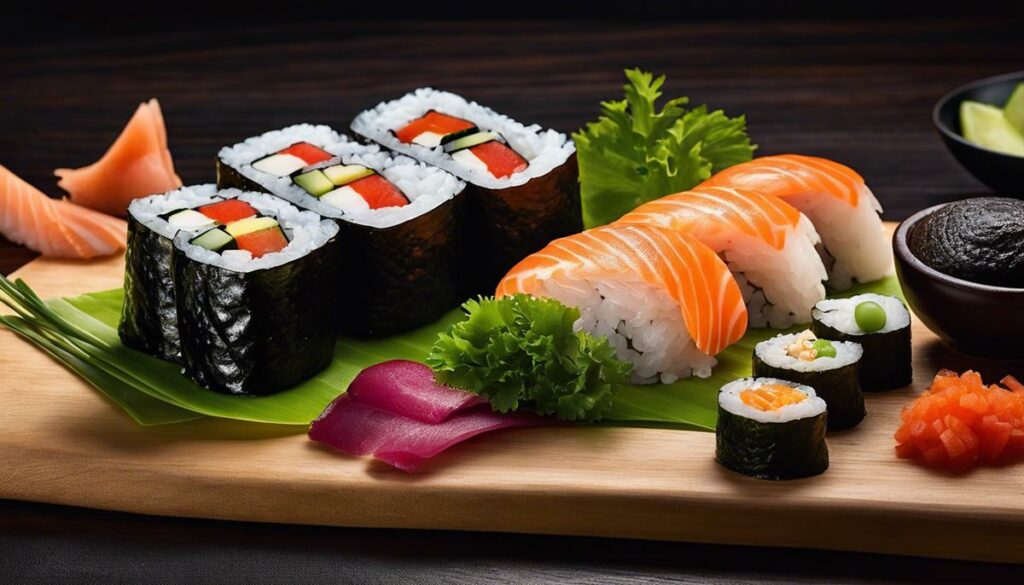Japan, the land of the rising sun, is known worldwide for its culinary gem – sushi. The art of sushi making is deeply rooted in Japan and reflects a centuries-old tradition that relies on excellent ingredients and subtle flavors. The freshness of the seafood, the seasonal availability of vegetables and the dedication of the sushi masters to their craft ensure that sushi in Japan is a very special taste experience. The subtle differences in taste and the careful presentation of the food are an expression of a culture that strives in every way to achieve harmony and perfection.
Ingredients and freshness
Lifestyle influencers beware: it’s time for a delicious journey into the world of sushi, a dish that not only delights the taste buds but also delights the eye. Oh, Japanese cuisine knows how to balance a true aesthetic with extraordinary flavors. But what makes the ingredients in Japanese sushi so special?
First, we’re talking about freshness, an incontrovertible rule in the sushi world. Whether it’s fish or seafood, freshness equals quality. The Atlantic tuna and the Pacific bluefin tuna (known as toro), the yellowtail mackerel or the tender sea urchin meat – these protein heroes are the superstars on the rice bed.
Then there is the rice, a canvas for the masterpiece. Sushi rice (Shari) is not just rice. It’s a perfect balance of stickiness, spice from rice vinegar and sometimes a hint of sugar – this is the foundation that lays the foundation for the symphonic sushi experience.
A feast for the eyes is undoubtedly the bright green wasabi, which is more than just a side dish. Real Japanese wasabi, grated right at the root, is smooth, zesty, and enhances the flavors without overshadowing the flavor palette.
Let’s also think of nori seaweed leaves; crispy and tasty at the same time, not only a roll seat, but also an essential part of the sushi aroma profile. They bring a touch of the sea and a subtle depth that every bite needs.
Not forgetting Gari, the pickled ginger, a pale pink elegance that cleanses the palate so that you can fully enjoy each new sushi creation. The slight sweetness and spiciness are the fine antithesis to the oily fish aromas and allow a perfect transition between bites.
So, whether it’s the precise art of rice, the freshly caught fish or the quality and uniqueness of the side dishes – it’s the details that make the difference. Each ingredient is essential and selected with the utmost care to make the sushi an unparalleled pleasure.
Let’s dive into this culinary rhapsody and appreciate the craftsmanship behind every bite of Japanese sushi. Who knows, maybe it is precisely in this perfection of ingredients that you will find the true key to beauty in life – one bite at a time.
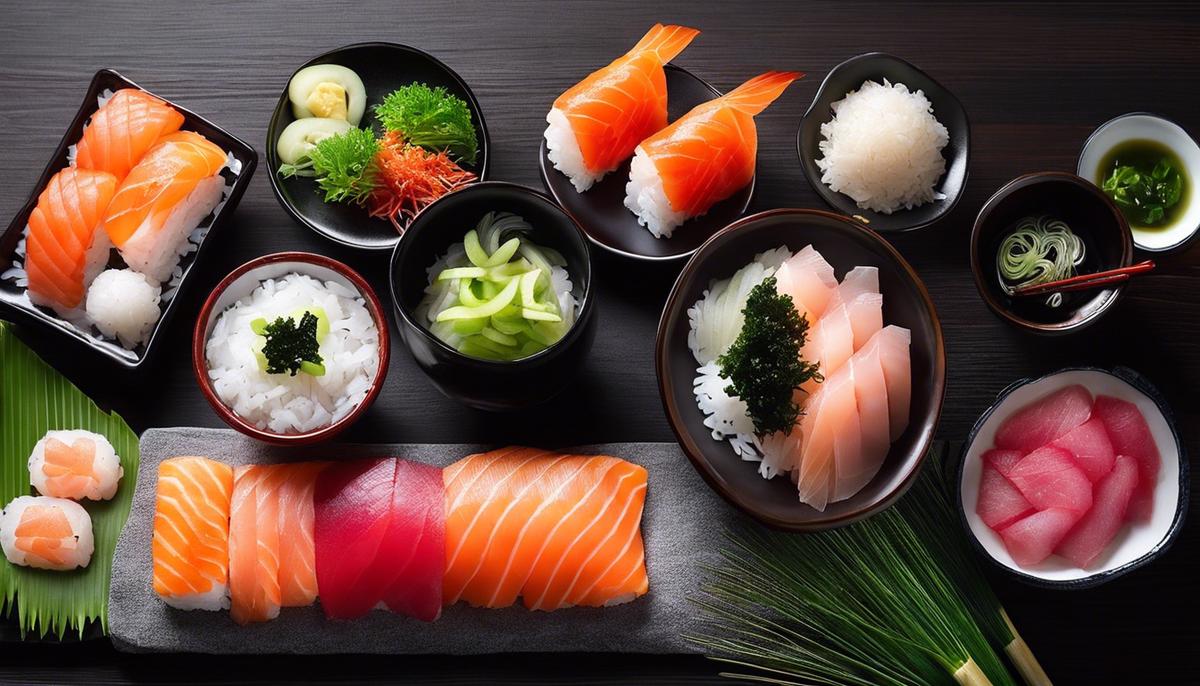
Culinary craftsmanship
In the dazzling world of sushi, where every bite is a tribute to aesthetics and taste, the culinary signature of the sushi master plays an invaluable role. It is not only the quintessence of the ingredients that counts, but also the filigree artistry with which the sushi master processes them.
A sushi master has a deep knowledge of the seasonal cycles of sea creatures. This intuition allows him to decide when, for example, tuna has its optimal fat content for nigiri or when a mackerel fillet tickles the taste buds in particular.
But the taste of sushi is not only determined by the what and when, but also by the way it is prepared. The cutting of the fish, an art in itself, has a decisive effect on the texture and therefore on the taste of the sushi. An oblique cut through the fibers or a filigree chasing of the fish can affect the melting of the delicacy on the tongue, a sensual pleasure that every gourmet appreciates.
But the picture of the perfect sushi is not yet complete. One aspect that is often overlooked is the temperament of the sushi master, which inevitably translates into the taste experience. The energy and passion that goes into every move are subtle spices that combine with the rice and fish. A sushi master with dedication and mindfulness doesn’t just create food – he creates poetry on the plate.
Another crucial factor is the timing of the composition. Sushi only reveals its true magic in the fleeting moment when it is served. The temperature of the rice, the coolness of the fish – all of this has to be to the point in order to communicate the untellable: umami.
Added to this is the anarchic creativity of a true sushi artist who manages to fuse traditional methods with innovative approaches. Fusion elements must not be allowed to overwhelm or dominate; they must honour classical music and at the same time give space to something new.
In conclusion, the interaction between guest and sushi master is not only gastronomic, but also spiritual. It’s about a connection that goes beyond the first bite and unfolds in a resonant space between artistry, awe and pure, unadulterated lust. The sushi master is not just a chef – he is a conductor who brings a symphony of the senses to life with every movement of his hand.
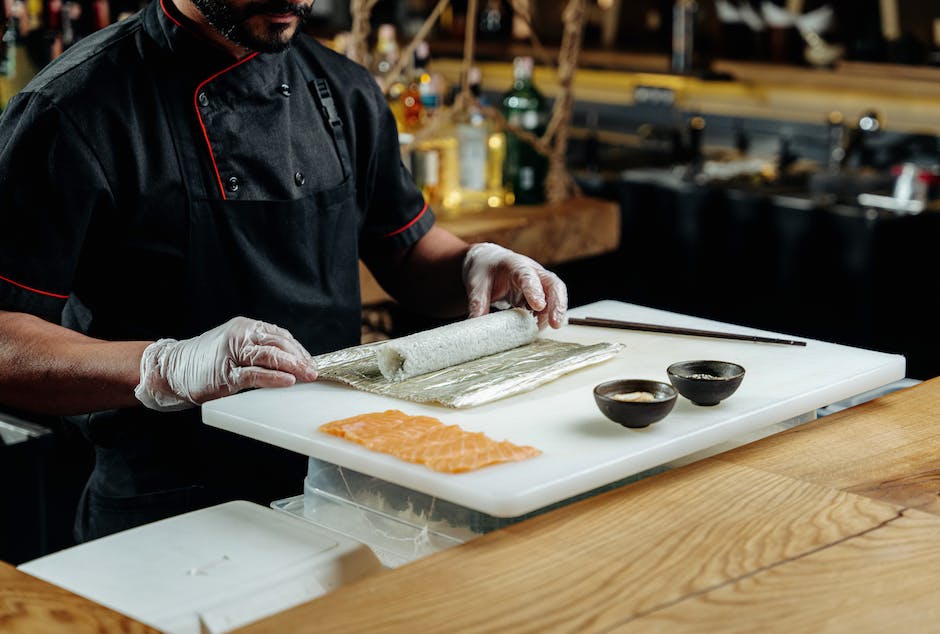
Food culture and atmosphere
A trip to Japan for a true sushi experience isn’t just a meal – it’s a sensual symphony that is only completed through the carefully curated ambience. The delicate design of a sushi restaurant in Japan is much more than a mere backdrop. It is a crucial ingredient that rounds off the entire experience in a pleasurable way.
When the sliding doors of a sushi restaurant close behind you, you are immersed in a world where every nuance has been considered. The minimalist elegance with clean lines and natural materials reflects the purity and simplicity that also characterizes the sushi itself. The feel-good ambience is created by soft, indirect light, which highlights the artfully arranged sushi on the shiny wood of the counter.
The sounds in an authentic sushi restaurant are also part of the ritual. A quiet murmur of conversation, punctuated by the occasional clink of the fine sake bottles and the subtle sound of knives gliding precisely through the fish, fosters an atmosphere of contemplative appreciation.
The interplay between sushi master and guest is enhanced by the setting. Each guest gets the best view of the skillful hand movements of the sushi master, which evokes an almost hypnotic fascination. It’s not just about seeing and tasting, but also about following the creation of each bite – a connection that is rare in this intimacy.
The placement of the seating, whether at the sushi counter or in private tatami rooms, creates a sense of community while still providing enough privacy. The arrangement is thoughtful to facilitate interaction with the sushi master while leaving room for personal moments.
The olfactory dimension is not neglected. The delicate scent of fresh wood, mixed with hints of sea and rice vinegar, subtly emphasizes the freshness and quality of the delicacies served, preparing the senses for the upcoming taste explosion.
Last but not least, the lovingly selected tableware, from artfully crafted sushi platters to the small soy bowls, conveys the feeling of genuine craftsmanship and individuality. Thus, every bite of sushi is accompanied by a perfectly coordinated aesthetic that celebrates the achievement of craftsmanship.
All these elements merge in harmony and make the sushi experience in Japan a matter for all the senses. Together, they form the backbone of an authentic environment that is destined not only to nourish but also enchant the gourmet. By designing the ambience with the same mindfulness and skill as the sushi itself, the culinary work of art is perfected until finally the eyes, ears, nose and palate sing in a chorus of approval.
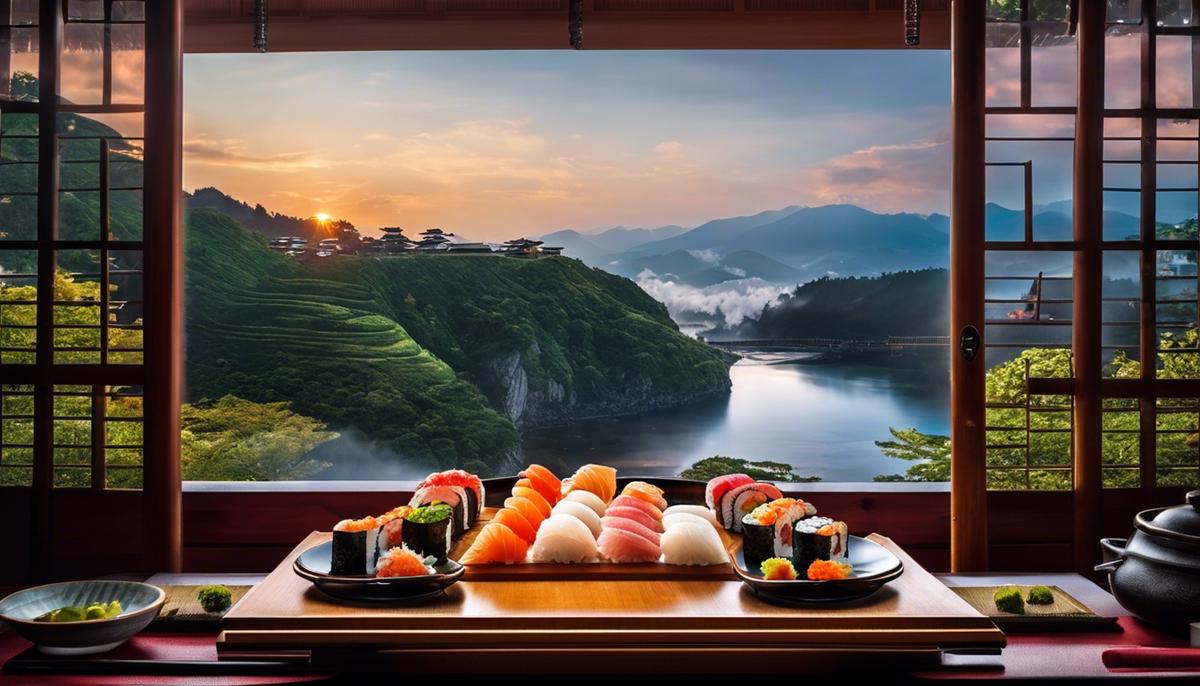
Terroir – the local influence
Japan is an island nation known for its diversity and abundance of natural resources. The regional characteristics – often referred to as terroir – play a central role in the production of food and also have a significant influence on the taste of the sushi prepared there.
The apparent versatility of Japan’s coastal landscapes characterizes the range of seafood. Each region competes with others for the title of ideal place of origin for a specific type of fish or seafood. The temperature of the water, the currents and the regional ecosystem have a direct influence on the growth and quality of marine life.
Aomori Prefecture, for example, is famous for its world-class scallops, while fugu, arguably the most famous pufferfish specialty, comes mainly from areas like Shimonoseki. The different conditions in which these animals live contribute to their unique texture and unmistakable taste – a taste that should never be considered in isolation, but is always in harmony with the environment and traditional cooking methods.
The influence of the regional terroir is also indicative of the variety of Japanese rice varieties. Despite the fact that sushi rice is often seen as the universal foundation for all sushi creations, the local differences in soil conditions and climate create an almost infinite palette of flavor nuances. The rice grown in Niigata Prefecture, which is known for its clean, smooth aroma, contrasts with the stronger-tasting rice from the Kyushu region.
Furthermore, the use of traditional ingredients such as soy sauce and miso paste varies from region to region. Their production processes are influenced by the local climate, which in turn determines how the sauces define the sushi experience. Whether it’s the lighter, sweeter soy sauce from the Kansai region or the darker, more intense version from Kanto, they all add a special flavor to the sushi flavor.
In addition, the seasonal locality must not be ignored. The use of seasonal ingredients, which reach their peak in each location, guarantees not only freshness, but also a harmonization of the sushi with the temporal and geographical context.
The preparation and serving of sushi in Japan is therefore not only a question of technique and experience, but also includes a deep connection to nature and geographical culture. The magic of sushi lies in its ability to bring all these regional factors to a plate and create a taste sensation that is deeply rooted in Japan’s scenic identity. A visit to a sushi restaurant in Japan is therefore not only a culinary experience, but a journey through the regional terroir and the aura of the surroundings.
So, the next time a piece of sushi delights the palate, it is an invitation not only to appreciate the elegance of the moment, but also to appreciate the stories and circumstances that give content and character to each bite. Wherever the journey takes you, sushi always gives you the feeling of experiencing a piece of Japan – in all its flavours and incomparable beauty.
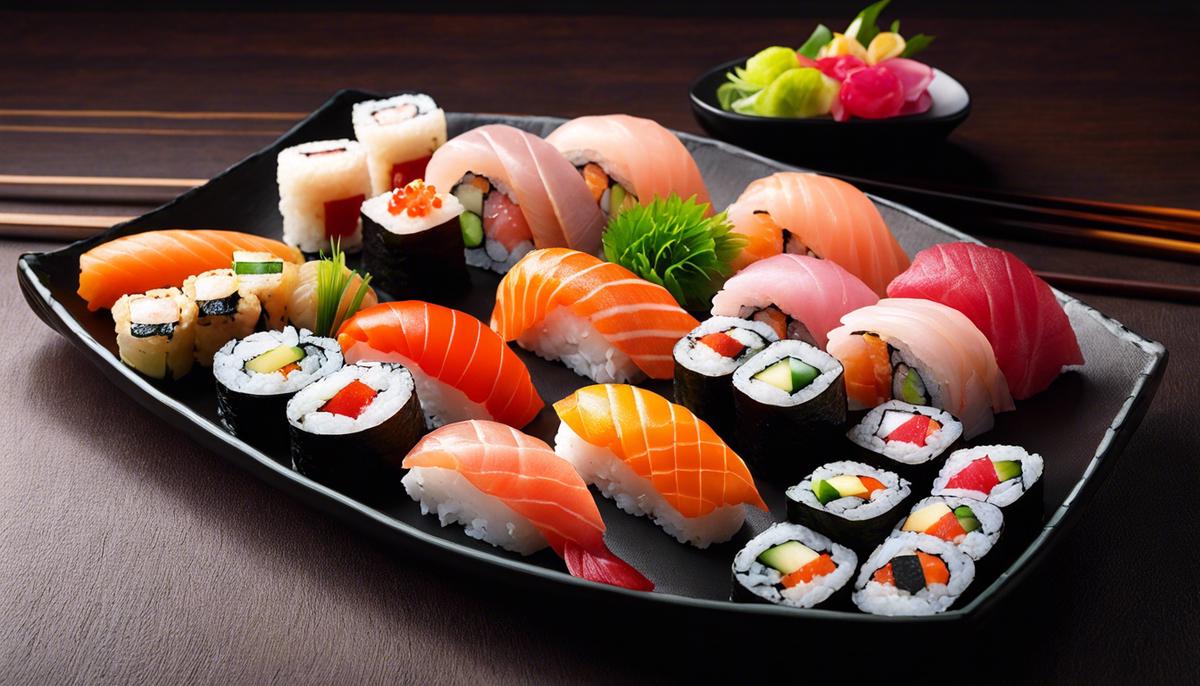
The multi-layered world of Japanese sushi reveals the importance of local ingredients, artistic craftsmanship, unique food culture, and regional influences. These aspects together form a harmonious experience that goes far beyond just eating and is reflected in the flavor profiles of the sushi. Those who have the opportunity to enjoy sushi in their home country of Japan will not only have a meal, but will also become part of the vibrant cultural mosaic that makes this exquisite cuisine so unique.
